[Situation Overview]
Looking at the overall yarn and fabric,The export scale of intermediate products has steadily expanded, and its proportion in my country’s textile and apparel exports has continued to increase. In 2023, yarn fabric exports will be US$77.9 billion, with export volume 6.7 times that of 2001, and its proportion rising to 26.7%. Among them, yarn exports amounted to US$13.7 billion and fabric exports amounted to US$64.2 billion, which were 5.2 times and 7.2 times those of 2001 respectively.
From the international market, exports to ASEAN and other major markets have stabilized. In the fourth quarter of 2023, exports of yarn fabrics to ASEAN increased by 13.8 percentage points compared with the third quarter. At the same time, the diversified international market structure is accelerating. At present, China’s annual exports of yarn fabrics to countries jointly building the “Belt and Road” account for more than 80%, and exports of yarn fabrics to Russia, Kyrgyzstan, Saudi Arabia and other countries have performed well. .
The Red Sea-Suez Canal crisis has had a certain impact on textile and clothing exporting countries, including China. Not only are the textile and apparel exports of Southeast Asian and South Asian countries to Europe greatly affected, but also the volume of Brazilian, American, African cotton purchased by some countries has declined, which has also had a greater impact on the trade in intermediate goods. Enterprises report that not only have freight rates increased significantly and profits have dropped significantly, but there is also great uncertainty in delivery times.
Cotton yarn imports increased rapidly from January to December
According to According to customs data, yarn import and export in 2023 will be US$19.68 billion, a year-on-year decrease of 2.9%. Among them, exports were US$13.7 billion, a year-on-year decrease of 8.6%; imports were US$5.98 billion, a year-on-year increase of 13.2%. Among them, cotton yarn is the most important category, accounting for 70% of yarn imports and 24% of total textile and apparel imports. Affected by the U.S. “Xinjiang-related Act”, my country’s demand for foreign cotton and cotton yarn imports continues to increase. In 2023, cotton yarn imports will reach 1.687 million tons, a year-on-year increase of 43.4%.
In December, my country’s yarn exports were US$1 billion, a year-on-year decrease of 10.1%, which expanded the decline from the previous month; exports were 442,000 tons, a year-on-year decrease of 9.4%. my country’s yarn imports were US$520 million, a year-on-year increase of 74.3%; China’s yarn imports were 189,000 tons, a year-on-year increase of 85.7%. Yarn imports boosted textile imports by 27 percentage points, and textile and apparel imports by 13.9 percentage points.
Due to the large price difference between domestic and foreign cotton yarns after the second quarter, importers’ willingness to order continues to increase, which has led to the recent arrival of imported yarns in Hong Kong, pushing up imports. Among them, India, Pakistan, and Uzbekistan’s cotton yarn exports to my country increased by 243.2%, 351.1%, and 867.1% respectively in December.
[Export situation]
my country’s main exports The market was mixed
1. Exports of yarn and fabrics to ASEAN recovered steadily in December
ASEAN is my country’s largest yarn export market, accounting for more than 20% of my country’s total exports. In December, my country’s textile and apparel exports to ASEAN were US$5.04 billion, a year-on-year increase of 2.2%. Exports of intermediate yarn fabrics were US$2.13 billion, a year-on-year increase of 5.9%. Among them, yarn exports were US$210 million, a year-on-year increase of 0.7%; fabric exports were US$1.92 billion, a year-on-year increase of 6.5%.
In 2023, my country’s yarn exports to ASEAN will be US$2.63 billion, a year-on-year decrease of 12.9%. From the perspective of commodity structure, exports to ASEAN are dominated by chemical fiber yarns, accounting for more than 75%, and cotton yarn exports account for 12%.
Vietnam: my country’s yarn exports to Vietnam from January to December were US$1.2 billion, a year-on-year decrease of 18.3%. From the perspective of importing countries, the United States and the European Union’s textile and apparel imports from Vietnam fell by 24% and 11.4% respectively from January to November, which is consistent with the decline in my country’s yarn exports to Vietnam.
Affected by weak global demand, the trade volume between Vietnam and the United States and Europe from January to November 2023 fell by 9.6% year-on-year, and exports of textile and clothing products to the United States fell by 10.6%. Exports to the EU fell by 16%.
Indonesia and Cambodia: From January to December, my country’s yarn exports to Indonesia and Cambodia were US$480 and US$300 million respectively, a year-on-year decrease of 5.5% and an increase of 1.1%.
Myanmar: my country’s yarn exports to Myanmar from January to December were US$110 million, a year-on-year decrease of 10.7%. Myanmar is the top three source of imports from Japan. Due to the continued weakness of Japan’s economy, it has a certain impact on Myanmar’s import of intermediate products.
2. my country’s exports to the three South Asian countries declined to varying degrees in December
Exports of yarn to India from January to December were US$1.41 billion, a year-on-year increase of 3%. India has surpassed Vietnam and has become my country’s largest yarn export market, accounting for 10.5% of my country’s exports. In December, my country’s yarn exports to India were US$90 million, a year-on-year decrease of 30%.
Yarn exports to Bangladesh from January to December were US$1.09 billion, a year-on-year decrease of 23.5%. The EU accounts for nearly 50% of Bangladesh’s garment export market. In December, my country’s yarn exports to Bangladesh were US$70 million, a year-on-year decrease of 17.7%.
Yarn exports to Pakistan from January to December were US$750 million, a year-on-year decrease of 17.6%. In December, my country’s yarn exports to Pakistan were US$70 million, a year-on-year decrease of 2.0%. Recently, the Pakistan Textile Association (APTMA) released a report stating that due to the sharp rise in energy prices, power and natural gas supply interruptions have led to the shutdown of more than a thousand textile factories and production.Can fall affect the demand for the middle.
3. my country’s yarn exports to the Middle East, America, and Europe will all decline in 2023
Middle East (21 countries): From January to December, Middle Eastern countries accounted for 10.4% of our yarn exports. From January to December, my country’s yarn exports to Middle Eastern countries were US$2.04 billion, down 0.6%. Among the major exporters to the Middle East, yarn exports to Turkey, Egypt, and Iran declined, by 4.6%, 3%, and 37% respectively.
(Note: 21 countries in the Middle East: Turkey, Egypt, United Arab Emirates, Jordan, Morocco, Iran, Saudi Arabia, Algeria, Tunisia, Israel, Iraq, Oman, Yemen , Lebanon, Syria, Kuwait, Sudan, Libya, Qatar, Bahrain, Palestine)
Americas: my country’s yarn exports to North America fell by 4.9% year-on-year from January to December . Yarn exports to Latin America fell by 10.7% year-on-year, with Brazil, Mexico, Colombia, and Peru all declining to varying degrees.
Europe: my country’s yarn exports to Europe fell by 3.1% year-on-year from January to December. Among the top ten countries and regions, exports to Poland and the United Kingdom showed double-digit growth, with export volumes of US$130 and US$73 million respectively, representing year-on-year increases of 48.4% and 31.7% respectively. Italy, Portugal, Germany and other traditional textile and clothing producing countries have experienced varying degrees of decline.
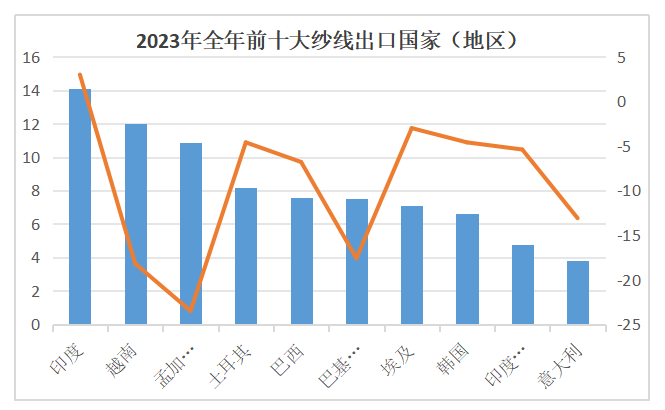
Yarn export volume and price divergence, corporate profits have been severely squeezed
Since this year, yarn export volume Continued growth, prices continued to decline under the pressure of export competition, and corporate profits were squeezed.
From the perspective of yarn exports, sluggish downstream demand and falling upstream raw material prices will cause yarn prices to fall further in 2023. From January to December, yarn exports were 6.062 million tons, a year-on-year increase of 10%; the unit price was US$2.26/kg, a decrease of 16.9%. The export quantity of yarn increased, and the export unit price dropped significantly.
Looking at monthly exports, since the third quarter, as the year-on-year decline in the factory price index for industrial products has narrowed, especially the price of clothing products has increased, export prices have also increased. The yarn export price in December was US$2.26/kg, down 0.9% year-on-year, 6.2 percentage points lower than last month, and 18.1 percentage points lower than the third quarter.
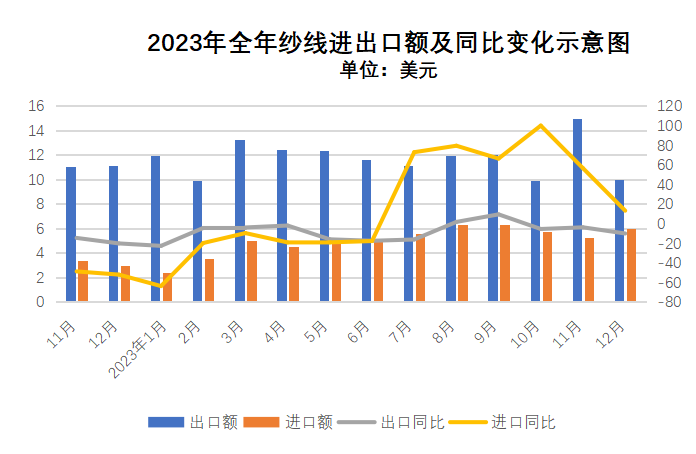
Looking at specific products, cotton yarn exports in 2023 were 236,000 tons, a decrease of 16.6%; exports were US$960 million, a decrease of 29.4%. Exports of chemical fiber yarns were 5.774 million tons, an increase of 11.8%; exports were US$11.48 billion, a decrease of 6.8%. Silk yarn exports were 3,000 tons, a decrease of 6.3%; exports were US$160 million, a year-on-year decrease of 1.8%; wool animal hair yarn exports were 23,000 tons, an increase of 2.3%; exports were US$830 million, a year-on-year increase of 0.9%.
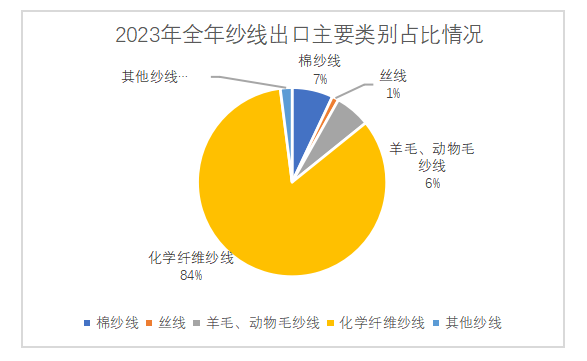
Exports from major provinces and cities declined
Coastal provinces and cities are the main force in yarn exports, ranking among the top five provinces The cities are Zhejiang, Jiangsu, Fujian, Shandong and Guangdong respectively, accounting for 80% in total. Yarn exports in the five major provinces and cities all declined. The export volumes of the five provinces and cities of Zhejiang, Jiangsu, Fujian, Shandong and Guangdong were 56.1, 28.3, 1.3, 7.1 and 570 million US dollars respectively, with decreases of 2.4%, 10.9%, 8.9%, 25.3% and 15.7% respectively.
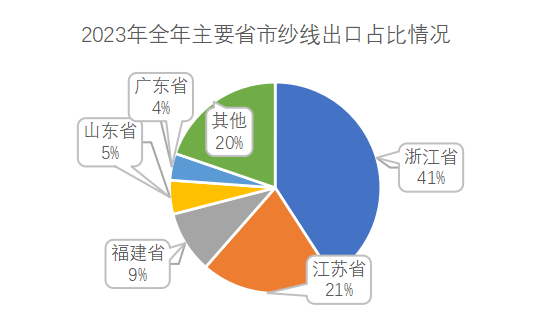
[Import situation]
The import of yarn from Uzbekistan has increased significantly
Affected by the U.S. “Xinjiang-related Act”, my country’s demand for foreign cotton and cotton yarn imports continues to increase. In December, the yarn import value was US$520 million, a year-on-year increase of 74.3%, and the import volume was 189,000 tons, a year-on-year increase of 85.7%. Yarn imports boosted textile imports by 27.2 percentage points and textile and apparel imports by 13.9 percentage points.
In 2023, my country’s yarn imports will be US$5.98 billion, a year-on-year increase of 13.2%, and imports will be 2.043 million tons, a year-on-year increase of 32.6%.
Looking at major product categories, imported cotton yarn will be US$4.39 billion in 2023, a year-on-year increase of 21.7%; the import quantity will be 1.687 million tons, a year-on-year increase of 43.4%; imported chemical fiber will be 13.8 million US dollars, a year-on-year decrease of 2.8%; imported silk thread, wool, and animal yarn were US$3.02 million and 140 million US dollars respectively, a year-on-year increase of 5.7% and an increase of 4%. my country’s yarn imports are dominated by cotton yarn, accounting for 70% of total yarn imports.
From the perspective of import sources, the top five sources of imported cotton yarn are all from Asia, and the top five sources together account for 90%. Imports from South Asia and the two countries increased, while the rest declined to varying degrees. Vietnam has always been the first source of cotton yarn imports in China. In 2023, 865,000 tons of cotton yarn were imported from Vietnam, a year-on-year increase of 19.1%, accounting for 42.3% of the total cotton yarn imports, and the import value reached 2.36 billion, a year-on-year increase of 1.6%, accounting for 42.3% of the total imports. 39.5% of the total, accounting for a decrease. Among the top three cotton yarn import markets, my country’s cotton yarn imports from Pakistan increased by 46.7%, and my country’s cotton yarn imports from India increased significantly, with an increase of 248.5%.
It is worth mentioning that Xinjiang’s imports of cotton yarn increased significantly from January to December, with the import value increasing by 830.1% and the import quantity increasing by 1124.1% year-on-year. The main import source country is Uzbekistan. First, according to reports from enterprises, in the second half of 2023, the price of imported cotton yarn in Uzbekistan has dropped significantly, by about 10%-15%, and the RMB price has reached about 21,000 yuan, which is certain to be competitive; second, after Uzbekistan suspended cotton exports, as a The export growth of semi-finished cotton yarn has obviously replaced the left and right; third, the international market demand has further recovered, and the domestic demand for cotton yarn has increased.
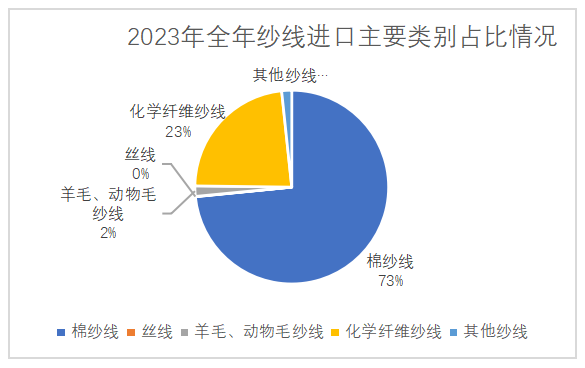
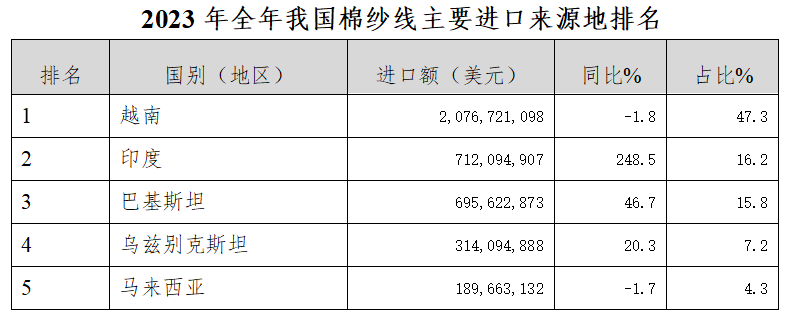
Yes, Xinjiang’s cotton yarn imports increased significantly from January to December, with the import amount increasing by 830.1% and the import quantity increasing by 1124.1% year-on-year. The main import source country is Uzbekistan. First, according to reports from enterprises, in the second half of 2023, the price of imported cotton yarn in Uzbekistan has dropped significantly, by about 10%-15%, and the RMB price has reached about 21,000 yuan, which is certain to be competitive; second, after Uzbekistan suspended cotton exports, as a The export growth of semi-finished cotton yarn has obviously replaced the left and right; third, the international market demand has further recovered, and the domestic demand for cotton yarn has increased.

 </p
</p







